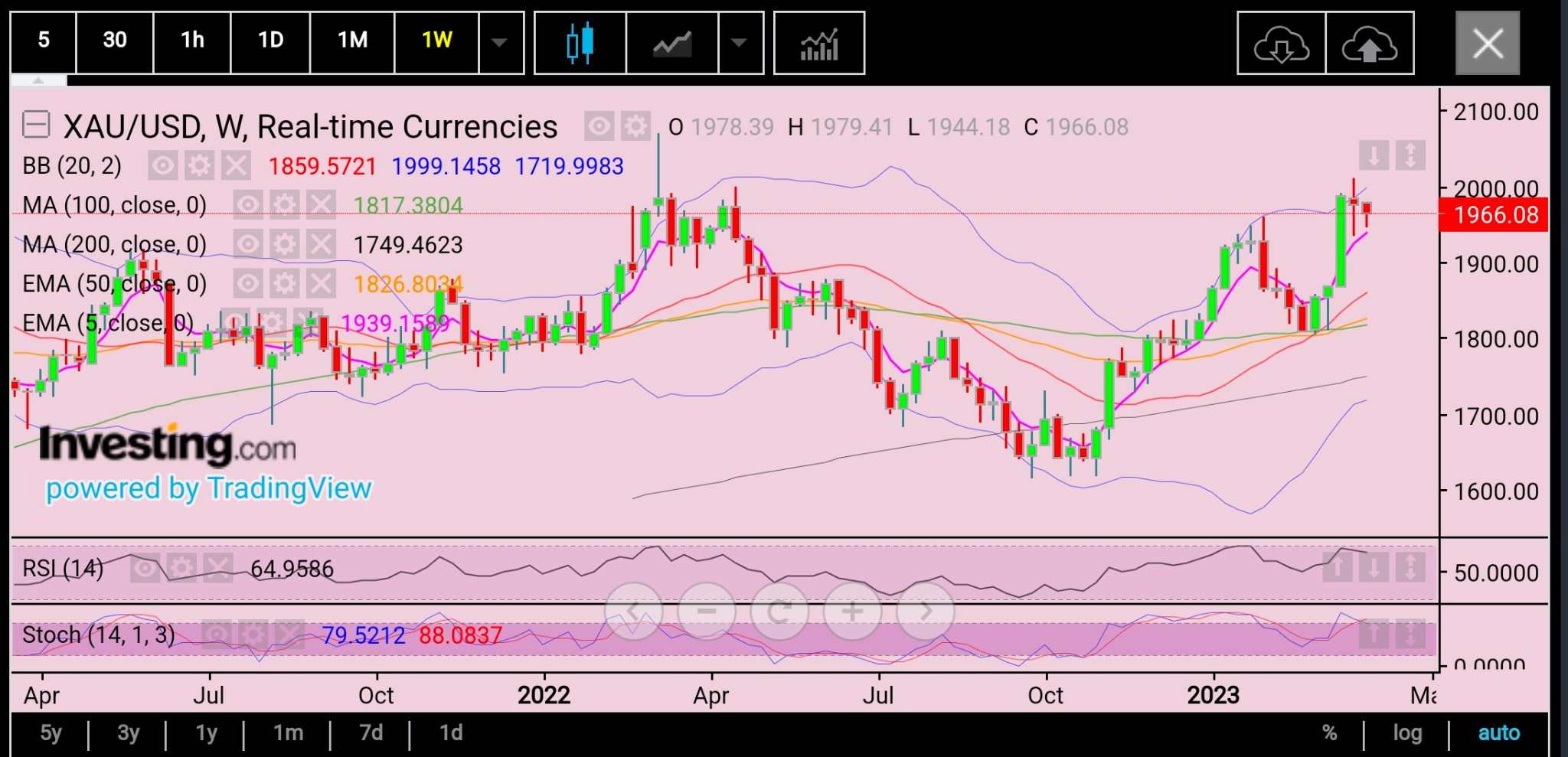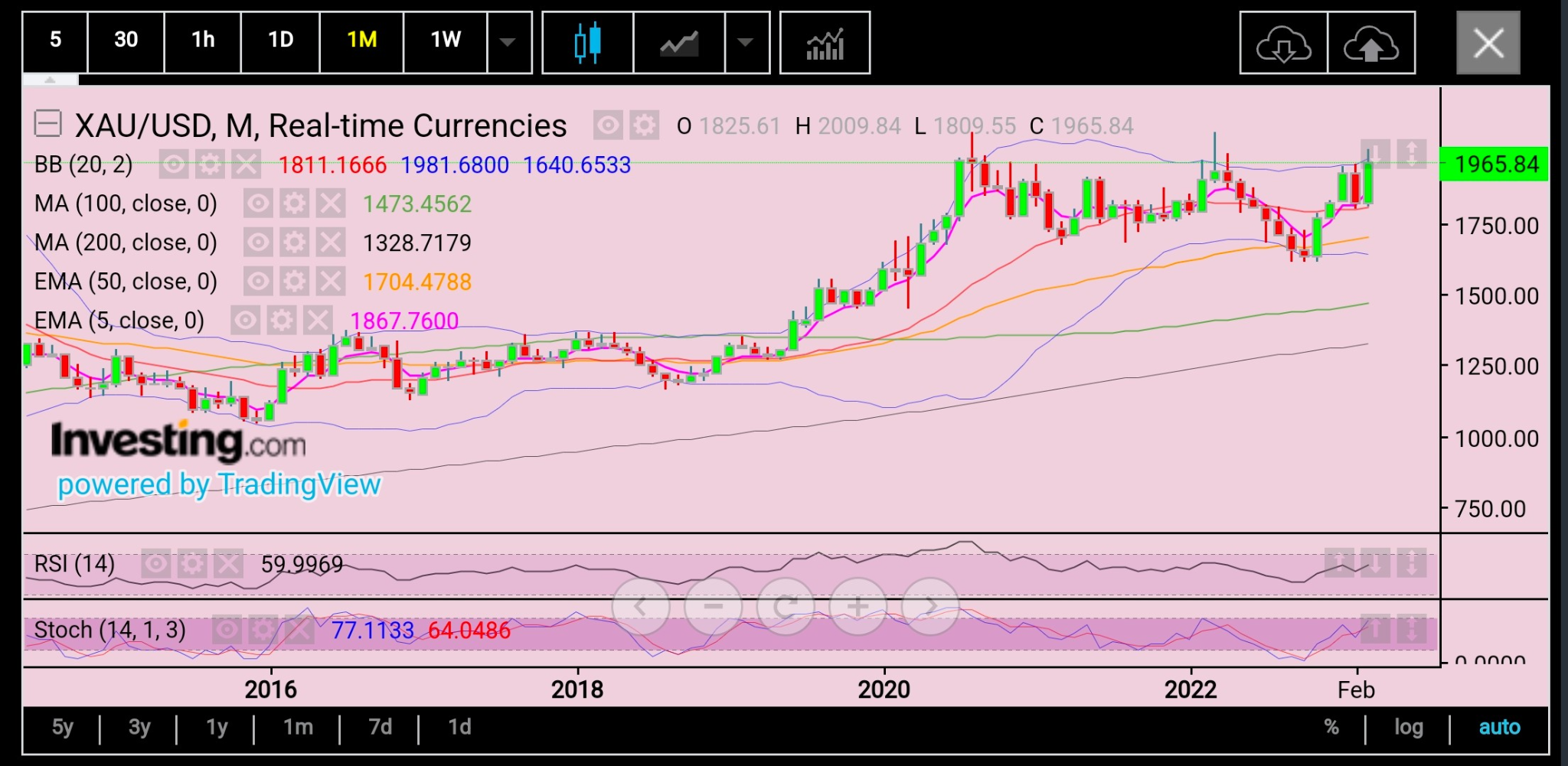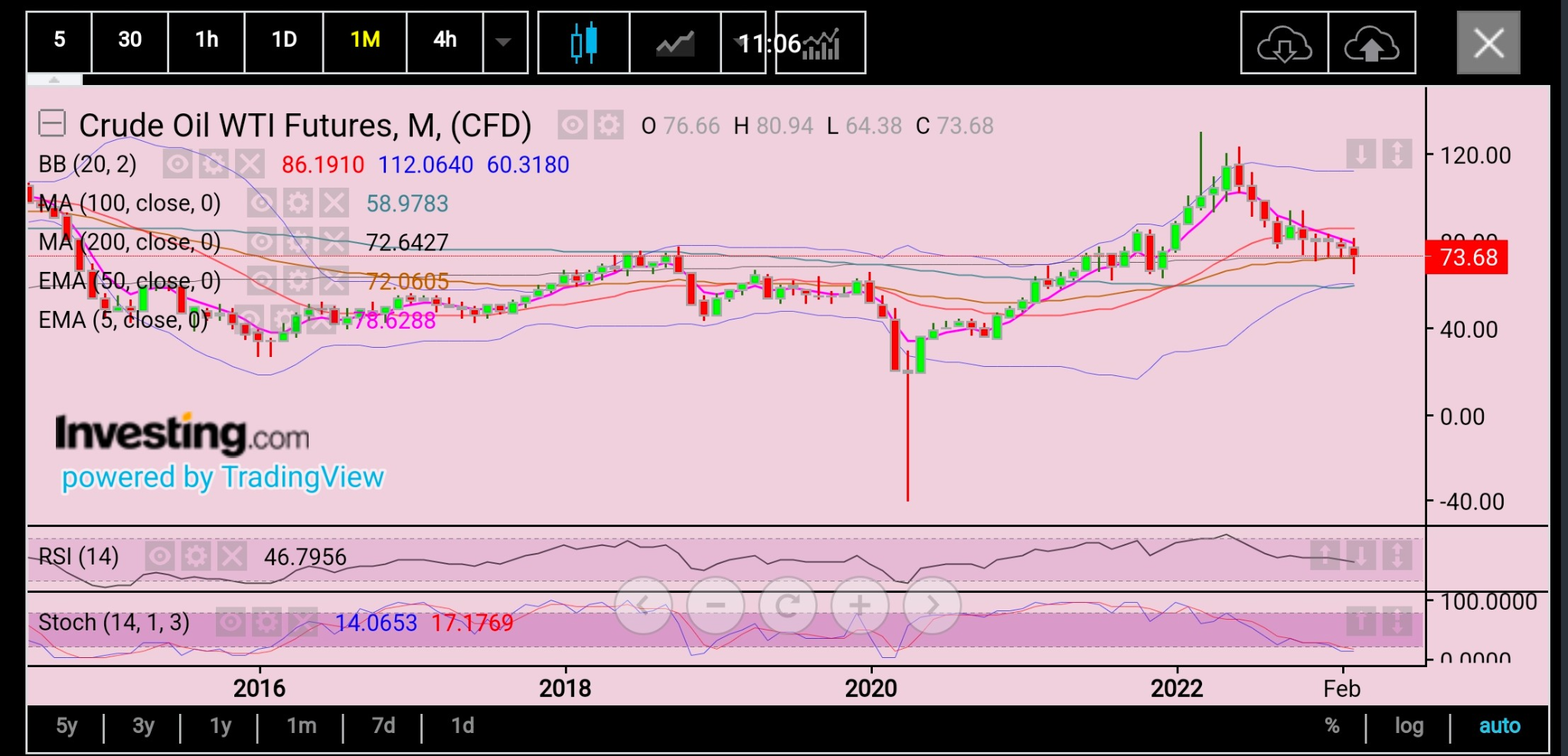- Gold up as much as 8% for first quarter versus oil’s decline of same
- Banking crisis flipped fortunes of world’s two most traded commodities
- Gold bugs aim to rewrite 2020 record high; oil has remote chance for $80
Let’s be honest: Few gold bugs would have envisioned $2,000 an ounce this quarter, just like how no oil bull would have dreamt a barrel beneath $70. The only reason both got there is probably because of the banking crisis.
Like a storm that blew out of nowhere, the confidence crisis in US banks — something that hadn’t occurred since the Great Recession; not even during the COVID breakout in 2020 — has practically changed the fortunes of the world’s two most traded commodities.
At stake in gold is the possibility of a new record high, reinforced by the yellow metal’s attempts to return to $2,000 levels despite the drone of assurance by US regulators that the nation’s banks were sound, resilient, and strongly capitalized, with adequate liquidity.
In Wednesday’s Asian trading, US gold for April delivery hovered at above $1,981 an ounce by 02:00 ET (06:00 GMT) ahead of its official open for the day on New York’s Comex.
Between Tuesday’s settlement and that hour, April gold had gotten to $1,994 after officially wrapping the previous day’s session at $1,973.50, up $19.70, or 1%. The benchmark gold futures contract exhibited such behavior last week before breaching the $2,000 target eyed by longs back-to-back in three sessions between Thursday and Monday.

Charts by SKCharting.com, with data powered by Investing.com
The spot price of gold, more closely followed than futures by some traders, got to above $1,975 in the US overnight session. At the time of writing, it hovered at above 1,963.
What’s making gold’s believers starry-eyed is the yellow metal’s breach of $2,000 in six of the seven trading sessions on Comex between March 17th and 27th. Prior to this stretch, the last time gold got above $2,000 was almost a year ago. The current rally has reinforced gold bugs’ conviction that a new peak futures rewriting the August 2020 record intraday high of $2,089.20 is possible. For spot gold, the record high to beat is $2,072.90, also from August 2020.
But as stated at the outset, the reason for gold to have run up this much this quarter is because of the banking crisis. With Friday marking the end of the March trading session, Comex gold is up more than 8%, and spot gold more than 7% quarter-to-date.
While inflation has been one of the drivers of gold’s gains over the three months, the banking crisis has certainly expedited its advance.
For a quick recap, the crisis basically revolved around the rescue of three US banks — two by the government and one by the US banking sector itself. Adding an international twist to the whole thing were troubles in Europe’s banking sector that blew up at around the same thing, resulting in the forced buyout of Switzerland’s Credit Suisse (SIX:CSGN) by compatriot UBS (SIX:UBSG) and the scarring of Germany’s Deutsche Bank (ETR:DBKGn) brand.
Gold Longs Aren’t Buying the Narrative of Safe & Sound Banks
Gold is primarily a store of value and safe-haven for many — something they wouldn’t buy if they really believed things around them were safe and sound. That it’s trying to get to new peaks despite the combined effort of three agencies — the Federal Reserve, the Treasury, and Federal Deposit Insurance Corp — to put a safe wrapper around US banks suggests the long gold crowd isn’t buying what it’s being told.
What’s more, gold bugs are betting the Fed will prematurely terminate the rate hikes the central bank has been doing over the past year and resort to cuts by the third quarter, in order not to do more damage to public confidence in the financial sector and economy.
Speculation is swirling around a rate freeze by May 3rd or June 14th, dates for the next two rate decisions. This is despite the central bank’s stated goal of not backing away from monetary tightening till its goal of lower inflation — ideally at 2% per annum instead of the 6% now — is achieved.
My money is on the Fed staying the course without cuts till the start of 2024. But Wall Street and gold bugs seem to have different ideas.
Said FXTM senior research analyst Lukman Otunuga said in comments carried by bullion trader Kitco on its website:
“While prices could trade lower in the shorter term to medium term, the longer term still remains in favor of bulls due to expectations around the Fed cutting interest rates in September.”
The Fed has added 475 basis points to interest rates through nine rate hikes over the past 13 months. Rates now peak at 5%. Few expect the central bank to go beyond a peak of 5.5% — meaning another two hikes at most based on the Fed’s most recent pace of 25 basis points per raise.
Craig Erlam, analyst at online trading platform OANDA, concurs somewhat with Otunuga.
Investors in gold don't think the banking crisis is behind them, instead believing that “scarring from it in credit markets has permanently reduced the tightening required from central banks”, said Erlam.
“That could be bullish, if so, for gold and traders may even have one eye on the all-time highs if rate cuts this year become a reality,” Erlam added.
So, where could gold go from here?

Technicals suggest that the spot price could go lower before resuming its rise, to reach peaks above $2,090, said Sunil Kumar Dixit, chief technical strategist at SKCharting.com. He adds:
“Consolidation around the support areas is very likely to be followed by a resumed advance to new highs one after another, most likely $2,090 first and $2,170 later.”
On the drop, he envisaged a drop below $1,960 to find buyers at around the support areas of $1,930, or even $1,920.
What’s important, he said, was that spot gold clings to both the 5-Day and 5-week Exponential Moving Average on a closing basis to sustain its momentum.
“A close of around $1,960 in spot gold will be supportive for its further alignment with the current record high of $2,073,” Dixit said. “As the metal looks prepared for a potentially bullish engulfing formation on the monthly chart, ongoing price action can work for continuation of bullish momentum.”
In Oil, the Bet Is That the Banking Crisis Has Peaked
The oil market is, meanwhile, rising for the exact opposite reason to gold: On the bet that the worst has probably been seen in the banking crisis.
On Tuesday, crude prices rose for a second day in a row since the start of this week, settling up about half a percent or so to add to the previous day’s 5% surge, as Senate testimony by the Fed’s supervisory chief Michael Barr did not expand on contagion worries many had been fearing about.
In a two-hour appearance before a Senate panel on banking, Barr stuck to the inadequacy in risk mismanagement and other “safe” practices at Silicon Valley Bank that led to billions of dollars in customer deposit withdrawals from the California-based lender and at least two other banks that triggered the crisis.
If traders were waiting to hear about contagion from the Silicon Valley fallout, they did not get such headlines — from Barr, at least.
For the record, the Fed’s supervisory chief already said in his pre-testimony speech on Monday that the central bank’s review showed the US banking system was “sound and resilient, with strong capital and liquidity”.
With no new developments on the crisis, a broad risk-on rally erupted across commodity markets that even lifted safe-haven instruments such as gold. Oil prices, particularly, had been badly impacted by the banking crisis, falling 13% two weeks ago before recovering about 3% or more last week.
“It appears that no news is good news, on banking at least,” said John Kilduff, partner at New York energy hedge fund Again Capital.
“It doesn’t mean there’s no possibility for a contagion here; we’ve read and heard enough about this crisis to know that this probably isn’t the end of it. For now though, there’s calm and that’s good for risk assets.”
Crude prices had already started the week strongly as traders learned about the disruption of half a million barrels a day from Kurdistan, amid nuclear war talks by Russian President Vladimir Putin.
The oil market is also being closely watched to determine how successful longs will be in trimming a significant loss for the first quarter that’s looming as Friday’s trade — the last for March — approaches. As of Tuesday afternoon in New York, both WTI and Brent were down about 8% each for the quarter.
Aside from the relatively positive outlook on banking and worries about Kurdish supply, oil prices could continue rising on signs that a three-month-long buildup in US crude stockpiles might be nearing its end as demand picks up ahead of the impending summer driving season. Weekly inventory data on Wednesday from the US Energy Information Administration will tell if that’s the case.

At the time of writing, New York-traded West Texas Intermediate, or WTI, crude hovered at above $73 per barrel, after rising 5.5% this week alone to add to last week’s 3.8% gain. WTI had lost 13% the week prior, eventually falling to a 15-month low of $64.38 as the banking crisis reached its height with the blow-up of Credit Suisse.
London-traded Brent crude hovered at above $78, after the previous day’s 0.7% gain that added to Monday’s 4.3%. Brent fell almost 12% the week prior.

Technically, WTI — often seen as an indicator of what could directionally happen for Brent — is in a position to get above $84, if oil bulls are lucky, said Dixit.
“WTI got the expected support at the 200-week SMA of $66,” he said, referring to the Simple Moving Average marker for the US crude benchmark. “Prices stay firmly positioned for more gains reaching $74.50, followed by the weekly Middle Bollinger Band of $76.50 over the short term.”
Remotely, there was a possibility of WTI closing the month above that Middle Bollinger Band mark, Dixit said.
“If that happens, we will see another wave of rally, towards the 50-week EMA of $82.45, followed by the 100-week SMA of $84.50.”
But he also cautions that things could turn ugly for oil bulls on the flip side.
“If the monthly chart’s candle fails to close above $76.70, we expect crude bears to return with a vengeance, aiming for $72.50 initially, followed by $68 and $66.”
Disclaimer: Barani Krishnan uses a range of views outside his own to bring diversity to his analysis of any market. For neutrality, he sometimes presents contrarian views and market variables. He does not hold positions in the commodities and securities he writes about.
